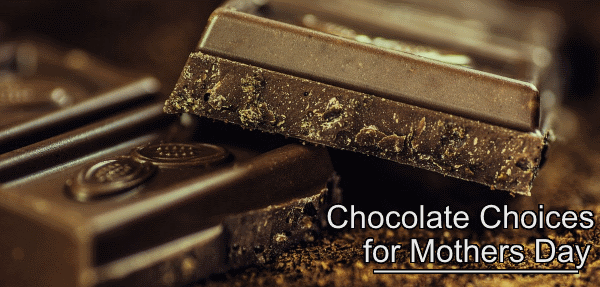In the UK this weekend it’s mother’s day this Sunday, yet another yearly opportunity on the calendar for card manufacturers, chocolate makers and flower sellers to make a quick buck selling tokens of affection to individuals who have left it far, far too late to get anything nice. It’s also technically the day when people are supposed to show appreciation for the mother figures in their lives.
That said, given the immense amount of crass commercialisation, it’s hard to imagine the far more benign beginnings of the holiday as a genuine attempt at showing appreciation for parents. Suffice to say, with the right marketing diploma you can turn anything into the next Valentine’s Day or Halloween!
Criticism aside, chocolates are by far one of the most popular gifts on mother’s day (or indeed on nearly any occasion). Which gives us a wonderful excuse to have a look at the different varieties of chocolate to see what makes them what they are.
Dark Chocolate
Unimaginatively named due to its darkest completion, dark chocolate is the way it is due to its far higher cocoa content – the core ingredient of chocolate. Bars of dark chocolate typically contain anything from 70% to 85% cocoa butter with the higher quality bars generally containing more.
Made by combining the cocoa with fat and sugar, dark chocolate is known for its bitter flavour which often means it is generally less popular than other varieties. The high cocoa content leave little room for the sweeteners other chocolate varieties include.
Still some people prefer their chocolate this way, and those that do enjoy a range of documented health benefits including:
- Lower Blood Pressure
- Protection against Oxidisation
- Improved Blood Flow
- Reduced Risk of Cardiovascular disease
It’s worth mentioning that, by the standards of confectionary at least dark chocolate is also quite nutritious containing plenty of needed minerals and fibre for the body. That said, it’s still a chocolate bar so is probably not an ideal replacement to fruit or vegetables in your healthy diet.
White Chocolate
At the other end of the appearance scale from its dark hued cocoa infused brethren, white chocolate is a pale white and yellowy type of chocolate. Only it isn’t really chocolate by many people’s definition. Though it often looks like and is shaped the same as the other varieties coming in chunky bars and other shapes white chocolate is so because it completely lacks any cocoa solids which is what makes it the colour it is.
It does however contain cocoa butter, but this is generally due to Government requirements in the United States that mandated all white chocolate contain at least 20% cocoa butter, 14% total milk solids and no more than 55% sugar. Adopted in Europe as well (with the exception of sweetener limits), these standards are what give “proper” white chocolate a more ivory colour.
Similar bars that are more pure white have likely been created with vegetable fat instead of cocoa butter which traditionally was and remains popular to do because cocoa butter is more expensive than other fats and also doesn’t taste so good by itself. Typically other flavours such as Vanilla are added to mask the bland taste of the cocoa butter. Still white chocolate does have some health benefits over its rivals – it is almost completely lacking in caffeine and theobromine which is the chemical that makes chocolate toxic to dogs. Though probably still not a good idea to let the family dog eat it if mother does not approve. 55% sugar is still 55%.
Milk Chocolate
Probably the most favourite chocolate in the western world if not globally, milk chocolate is what you get when you take chocolate and add milk to it as the name implies. Milk Chocolate contains a far smaller amount of cocoa than dark chocolate does with milk, sugar and flavourings making up a much higher percentage of the bar.
Generally those bars of chocolate that possess higher amounts of cocoa are regarded as more high quality and might include anything up to about 45% of cocoa butter. However amounts varying from 20 – 30% are generally more common with 30% being the amount of combined cocoa products (butter, liquor, solids) in an American or European bar.
A few exceptions exist such as for the UK where many chocolate producers for mass market products make chocolate with only 20% cocoa products minimum. EU law requires such product, when sold to the rest of the EU be labelled as “Family Milk Chocolate” to differentiate it from the regular product.
Though levels of quality do exist, in general Milk Chocolate is the treat of the masses manufacture in huge amounts to meet demand for sweet treats. Health concerns don’t rate highly in the manufacture of it and any health benefits are almost certainly wiped out by the huge amount of sugar it contains.
Still, surely sometimes that’s just what a mother wants, something sweet as a gesture of appreciation?




